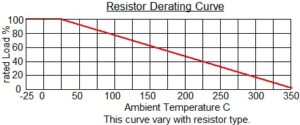A. Choosing Power Wire Wound Resistors and parameter determination:
1. Resistor power: W=I2*R where :
W = resistor power I = maximum loading current
R = rated resistance or the maximum rheostat resistance value
2. Never overload a power resistor beyond the specified voltage, power and current.
3. We recommend choosing a resistor with a rated power of at least 1.3 to 4 times higher than the actual loading power if your application requires the resistor to run continuously at full power. Extra safe margin power/current can extend the resistor’s service life and lower its surface temperature.
4. If the maximum or surge power is larger than the rated resistor power, please tell the actual working condition like peak/surge voltage, resistance value, duty cycle, loading duration, repetition rate and any cooling system around.
5. If the surge/peak voltage is larger than the rated resistor Voltage = SQR(P*R), please tell us the peak-to-peak voltage range, duty cycle, repetition rate per unit time or frequency, loading time and any cooling system around.
6. Most of our resistors can withstand 5-10 times the rated power for 5 seconds, depending on the current pulse width, resistor series, installation and cooling system.
7. There are no standard resistance values for the power resistors. It is better to tell your application’s working voltage, loading duration and duty cycle for the Low Ohmic Power Resistors. A different voltage can induce a very different resistor current. Different raw materials and production processes might need to withstand the higher current and temperature.
For example, the loading current for 1 ohm and 5 ohm 10kW power resistors are 100A and 44A, respectively.
8. The resistor’s maximum working voltage must obey Ohm’s Law SQR(P*R)
9. We recommend choosing Low-Inductive Resistors for frequency sensitive applications.
10. Most of our power resistors can be manufactured according to customers’ applications like resistance, rated power, resistor size, mounting fixture and inductive/low inductive, pulse voltage condition, etc.
11. Do not touch the resistor after connecting to a power source due to the High Surface temperature and the chance of getting ELECTRIC SHOCK.
12. The salty, dusty and corrosive environment can affect the power resistor performance.
B. Other application notes:
1. The resistor surface temperature can reach as high as 100°C to 500°C while at full load, depending on resistor series, rated power, resistance value, working conditions, ambient temperature and cooling system design, etc. In general, keeping the resistor surface temperature below 150°C to 250°C, depending on the above factors, can stabilize the resistance value and extend the resistor service life.
2. Adding a cooling system such as external forced cooling fans can lower the resistor surface temperature. Do not cover the resistors!
3. Use guards and warning labels where necessary for the power resistors.
4. We recommend keeping all temperature sensitive components away from the resistor.
5. Below is one of the Derating Curves for power resistors in general. Please contact us for an individual resistor’s derating curve.

6. Always clean the resistor tab terminals before connection. Do not clean the resistor surface with organic solvents.
7. Do not scratch the resistor surface with any hard or pointed object.
8. DDR-F and DQR-F series power resistors coat with a UL 94V-0 silicone coating. The resistors should be installed away from any flammable materials.
9. Silicone coated resistors might emit smoke during initial power loading. It is a normal phenomenon. After loading at 100% for 1-2 hours, the smoke emission will stop.
10. The ASZ, AHR and HER resistor external metal enclosure can be a source of interference for most sensitive circuits. Grounding the resistor metal housing can solve this concern.
11. All our load banks RB3A, RLB3A, RB, DB, RBA, DSR-WB, DSR3-WB, FVRB, and RBC series should be Ground connected before connecting to the load source.
C. Adjustable Wire Wound Resistors DSR-F / Rheostats FVR / Rheostat Boxes FVRB and DSR-WB series application notes:
1. Rheostat and Adjustable Wire Wound Resistor are a type of wire wound resistors.
2. From a material perspective, the allowable current depends on Ohm’s Law and the resistance wire’s current carrying capacity, whenever the lower one. Loading beyond this current range can damage the rheostat.
3. The function of a rheostat is to adjust the circuit current between the maximum current at the minimum resistance and the minimum current at the rated resistance.
Ci. Rheostat parameters determination:
1. Rheostat rated Power = (rheostat maximum load Current)2 x rated Resistance
2. The current of an existing application determines the maximum load current before the adjustable power resistor or rheostat is inserted. This consideration is for circuit current adjustment – a rheostat in series with a fixed resistor ( the equivalent circuit).
3. The maximum current for two rheostats with the same rated power can be very different.
For example, the load current for 1 ohm and 5 ohms 10kW power rheostats are 100A and 44A, respectively.
There are no standard resistance values for power rheostats.
4. The rheostat minimum resistance value can be calculated using the maximum current and voltage.
5. The rheostat maximum resistance value can be calculated using the minimum acceptable current and the voltage.
6. The rheostat working power needs to decrease as the resistance is adjusted towards its minimum value.
The working power at the adjusted resistance is about the ratio of (adjusted resistance) to (the rheostat rated resistance) x ( rated rheostat power) or
i.e. from the material viewpoint : power per unit resistance
Cii. Other rheostat application notes:
1. Load current at any adjusted resistance value =< rheostat rated current
2. Load power at any adjusted resistance value =< rheostat rated power
3. The rated resistance value is not the same as an adjusted resistance value.
4. The voltage across a rheostat might need to decrease to avoid overcurrent when adjusting the resistance value towards its minimum value.
5. A fixed power resistor can be connected in series with the rheostat to protect it from overcurrent damage.
The rheostat rated resistance = rheostat power / (maximum load current)2
The rheostat power = (maximum load current)2 x rated resistance.
6. The main role of Adjustable Power Wire Wound Resistor DSR-F, Rheostat FVR, Rheostat Box FVRB and DSR-WB is to decrease, not increase, the electrical current in the circuit.
7. Rheostat is for “continuous load current” adjustment – nearly “continuous resistance” range design.
8. For some situations, we may suggest RBA series adjustable load bank.
The load power / current adjustment by preset steps / switches / circuit breakers – discrete resistance values.
With different ON/OFF combinations, a different load current can be achieved.
Ciii. Other rheostat application notes:
1. Resistance adjustment is achieved by sliding the metal brusher across the metal resistance material.
There is a chance of flashover between two metal parts when the resistance is being adjusted, especially at high voltage, current and/or power conditions.
It is better to power OFF the load source across the rheostat before adjusting the resistance values.
2. Do not touch the adjustable resistor / rheostat after connecting to the power source due to high surface temperature and avoid ELECTRIC SHOCK.
3. We recommend choosing a rheostat with a rated current of at least 1.3 times higher than the circuit maximum current if any application requires the rheostat to run continuously at the full power. An extra safe margin power/current can extend the rheostat’s service life and lower its surface temperature.
4. Due to high power application and rheostat consisting of metal movable parts, we suggest installing the rheostat on a fixed and level bench to avoid vibration.
5. The salty, dusty, humid, high temperature, vibration and corrosive environment can affect the rheostat performance.
6. Both sections A and B are valid for the rheostats.
Cvi. Rheostat Bank FVRB / Adjustable Load Bank DSR-WB options:
1. Meter : Ammeter, Voltmeter, Wattmeter, Ohm meter and Temperature meter
2. OverCurrent protection
3. OverVoltage protection
4. Thermal protection
5. Cooling Fans system
